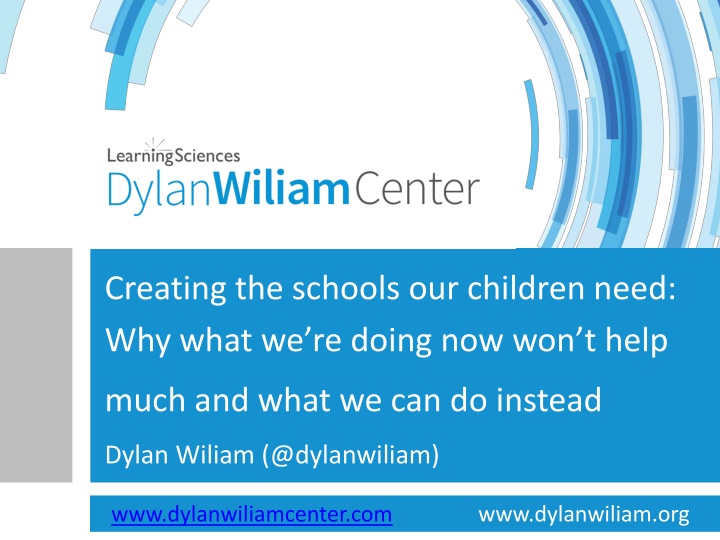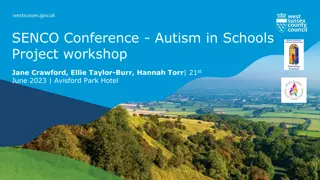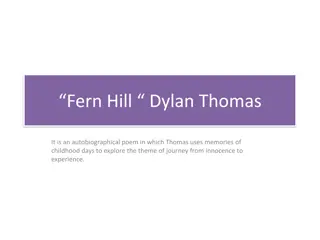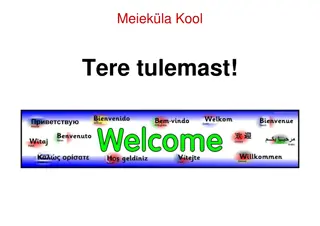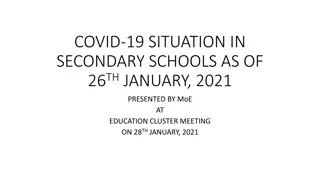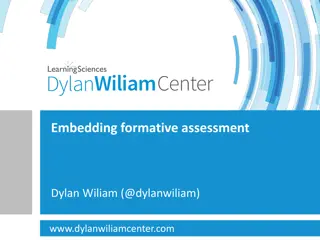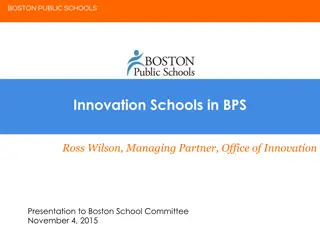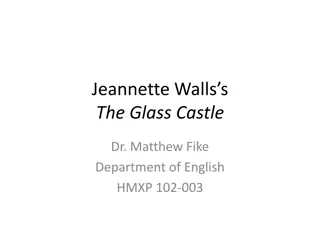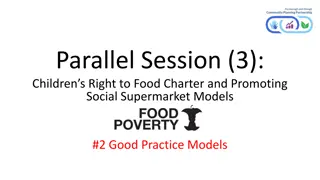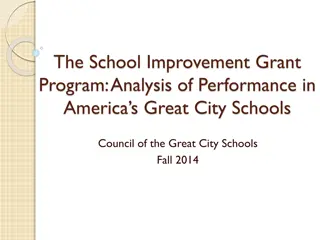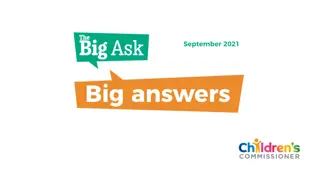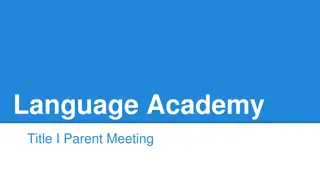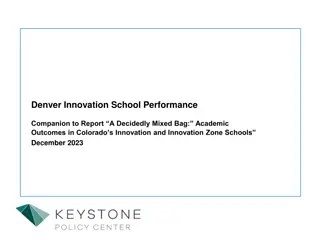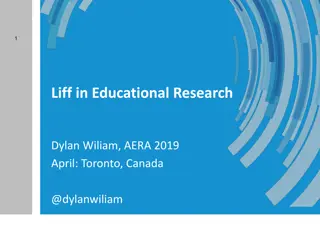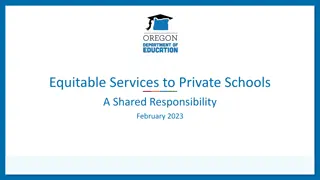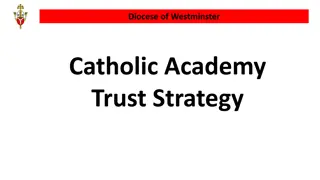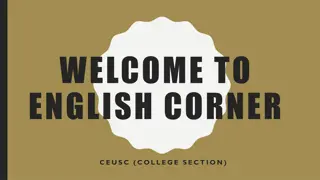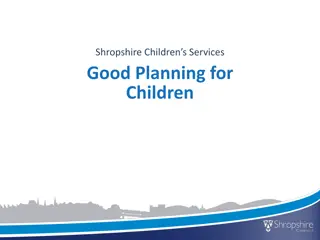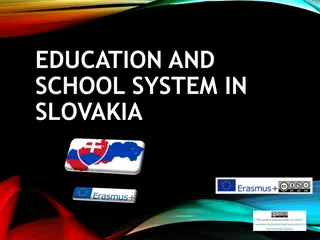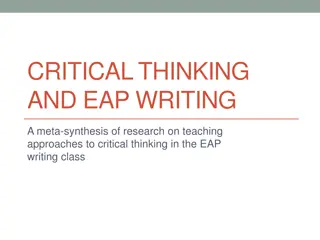Creating the Schools Our Children Need: A Critical Analysis by Dylan Wiliam
Implementing effective changes in the education system, Dylan Wiliam challenges current practices and proposes alternative strategies to enhance American education. Highlighting the importance of a knowledge-rich curriculum and teacher development, the discussion delves into the pressing need to raise student achievement levels to prepare them for future challenges in an evolving world.
Download Presentation

Please find below an Image/Link to download the presentation.
The content on the website is provided AS IS for your information and personal use only. It may not be sold, licensed, or shared on other websites without obtaining consent from the author.If you encounter any issues during the download, it is possible that the publisher has removed the file from their server.
You are allowed to download the files provided on this website for personal or commercial use, subject to the condition that they are used lawfully. All files are the property of their respective owners.
The content on the website is provided AS IS for your information and personal use only. It may not be sold, licensed, or shared on other websites without obtaining consent from the author.
E N D
Presentation Transcript
Creating the schools our children need: Why what we re doing now won t help much and what we can do instead Dylan Wiliam (@dylanwiliam) www.dylanwiliamcenter.com www.dylanwiliam.org
Outline 2 Why we need to improve American education What we re doing right now Getting smarter people into teaching Firing bad teachers Paying good teachers more Reducing class size Copying other countries Expanding school choice What we can do instead Developing a knowledge-rich curriculum Improving the teachers we have
Why we need to raise achievement 3 US students leaving school without basic levels of achievement in: Reading: 20% Mathematics: 30% Science: 20% In any of these: 15% In advanced economies, over the next 20 to 30 years 25% to 35% of jobs could be offshored About half the work being done right now could be done by machines with existing technology OECD (2017); Blinder (2011); Frey & Osborne, 2013; McKinsey (2015)
4 What we re doing right now (and why it won t help much)
5 Getting smarter people into teaching
Teacher preparation, student progress 6 Mathematics Mathematics Reading Reading Primary Primary Middle Middle High High Primary Primary Middle Middle + High High General theory of General theory of education courses education courses Teaching practice Teaching practice courses courses Pedagogical content courses content courses Pedagogical + + Advanced Advanced university courses university courses + Aptitude test scores scores Aptitude test Harris and Sass (2007)
7 Firing bad teachers
Effects of removing low-performing teachers 8 Data: reading scores for 4th and 5th grade students in Florida s public schools from 2004-05 to 2008-09 A total of 227,014 students (96%) are matched to 15,152 teachers responsible for teaching reading A value-added score is estimated for each teacher each year Two policy options explored for teacher removal: Value-added score below threshold for two consecutive years Two-year average value-added score below threshold Winters and Cowen (2013)
System-wide impact 9 Remove all teachers in the bottom Extra days of learning per student per year Policy 5% 0.0 10% Consecutive years 0.5 25% 1.5 5% 1.5 10% Two-year average 2.0 25% 3.5
10 Paying good teachers more
Differentiated compensation 11 Paying all teachers more does seem to increase student achievement Paying good teachers more No link between teacher qualifications and student progress Many failures (Nashville, NYC) Some successes Washington DC Impact scheme Teacher Incentive Fund One off bump (3 to 4 weeks extra learning in the second year) No improvement after that Not sustainable because of cost Dolton & Marcenaro-Gutierrez (2011); Chiang et al. (2017)
12 Can we identify good teachers by observation?
Do we know a good teacher when we see one? 13 Experiment 1 Seven teachers (3 high-performing, 4 not) Group 1: at least 0.5 sd above mean value-added for 3 years Group 2: never 0.5 sd above average value-added in 3 years 7 video clips shown to 100 raters Average number of correct ratings: 2.8 Distribution of total correct ratings 0 1 2 3 4 5 6 7 1% 11% 29% 36% 13% 9% 1% 0% Strong, Gargani, and Hacifazlio lu (2011)
Ratings by rater type 14 Rater Number Accuracy (%) Teachers Parents Mentors University professors Administrators Teacher educators College students Math educators Other adults Elementary students 10 37 37 47 41 31 31 36 34 43 50 7 10 9 10 10 11 10 11 12
Bias in lesson observations 15 A study of 834 teachers from six large US school districts found that teachers were more likely to be given a higher observation rating if they were teaching students with higher achievement. Compared with teachers teaching the lowest achieving students (bottom 20%), those teaching the highest achieving students (top 20%) were: 2.5 times as likely to be top-rated in English 6 times as likely to be top-rated in mathematics
16 Can we identify good teachers from test scores?
Value-added: Different models, different answers 17 Analysis of teacher value-added estimates from ACT scores Subject Algebra I teachers Algebra II teachers Biology teachers Chemistry teachers 10th-grade English teachers 11th-grade English teachers Geometry teachers Total Number of teachers 22 36 31 26 25 34 38 212
Teachers allocated to quintiles of quality 18 Cross-classification of the percentage of teachers classified in quintiles of teacher quality using two different value-added models Student fixed-effects model 2 1 3 4 5 Traditional model 1 38 22 24 16 0 2 26 28 15 20 11 3 20 20 20 24 16 4 13 24 26 13 24 5 9 5 12 28 47 Goldhaber, Goldschmidt, and Tseng (2013)
19 Can we identify good teachers by combining evidence from different sources?
Measures of Effective Teaching project 20 Three sources of evidence on teacher effectiveness Value-added estimates Classroom observation Student perception surveys Bill and Melinda Gates Foundation (2012)
Prediction and reality 21 Teacher rating To get a reliable estimate of a teacher s quality, you would need to collect data on that teacher for 11 years How good the teacher actually is
22 Reducing class size
Class-size reduction programs 23 In general, students taught by the same teacher in a smaller class will make more progress, depending on Age of the students Support for the teacher Supply of additional teachers However, meaningful reductions in class size are costly Reducing class size from 30 to 20 requires increasing education expenditure by 40% There are better things to do with the money
24 Copying other countries
Issues with international comparisons 25 Test translation Student motivation Unrepresentative samples Figuring out the causes Implementation
26 Expanding school choice
Charter schools 27 In the US, between-school differences are small Charter schools Some charter schools are highly effective (KIPP, Uncommon schools) Most are similar to traditional public schools System-wide impacts will be small even if all charter schools are as good as KIPP schools, and charter schools places expand at their current rate (250,000/year), we will have students making 3 week more progress each year by 2058
Educational vouchers 28 US student performance on PISA 2012 Public Reading 498 Math 481 Science 497 But, taking into account differences in students, in mathematics, Public schools outscore private schools by 7 points And, taking into account peer effects: Public schools outscore private schools by 27 points Private 527 496 518
Pause for reflection 29 What s the most interesting, surprising, or challenging thing you have heard so far? See if you can get consensus with your neighbors.
30 What we can do instead
Learning from research 31 Three questions we should be asking How much will this improve learning? How much will it cost? Will it work here?
32 A knowledge-rich curriculum
Copy this 33
Countdown game 34 Target number: 127 3 25 1 9 4
Memorization of spoken digits 35 500 400 World record for the memorization of single digits, spoken at the rate of one per second 300 200 100 0 1900 1920 1940 1960 1980 2000 2020 World Memory Statistics (2015)
Memory in chess 36 Studies of memory in chess Djakow, Petrovskij, and Rudik (1927) Adriaan De Groot (1946) Chase and Simon (1973)
Perception in chess 37 Three chess players were shown a chess board for five seconds, and then asked to reproduce what they had seen. Two scenarios Middle game (30 to 40 moves in, 25 pieces on board) End game (80 moves in, 12 to 15 pieces on board)
Memory in chess (1) 38 Player level Number of pieces correctly placed Mid-game Novice Club player Expert 5 9 16 Player level Number of pieces correctly placed Random Novice Club player Expert 2 3 3
Memory in chess (2) 39 Player level Number of pieces correctly placed End game Novice Club player Expert 4 7 8 Attempts to simulate the performance of the expert chess player with computers suggest that the expert can recognize at least 10,000 but probably fewer than 100,000 different arrangements of chess pieces or chunks, with a most likely value around 13,500 (Simon & Gilmartin, 1973)
A model of human memory 40 Short-term memory Long-term memory Environment Limited Limitless The purpose of education is to build domain- specific knowledge i.e., long-term memory
Reading ability and soccer knowledge 41 17.0 16.4 11.1 11.0 Schneider, K rkel, and Wiener (1989)
What is learning? 42 Learning is a change in long-term memory (Kirschner, Sweller, & Clark, 2016 p. 77) The aim of all instruction is to alter long-term memory. If nothing has changed in long-term memory, nothing has been learned. (ibid p. 77) Novices need to use thinking skills. Experts use knowledge (Sweller et al., 2011 p. 21)
Why curriculum matters 43 Myths about curriculum Standards tell us what to teach Curriculum means textbooks Knowledge isn t important ( You can always Google it ) Students should be involved in authentic tasks We should be teaching skills, not content Responding to students interests closes achievement gaps What is the purpose of curriculum? The real purpose of the curriculum is to increase the contents of long-term memory
44 Investing in the teachers we already have
Where should our efforts be focused? 45 Which of these is most strongly associated with high student achievement? A. Student speaks the language of teaching at home B. Student behavior in the school is good C. The amount of inquiry-based teaching D. The amount of teacher-directed teaching E. The school s socio-economic profile Top 3 factors 1. Student s socio-economic profile 2. Index of adaptive instruction 3. The amount of teacher-directed instruction OECD (2016, Fig II.7.2)
General conclusions about expertise 46 Elite performance is the result of at least a decade of maximal efforts to improve performance through an optimal distribution of deliberate practice What distinguishes experts from others is the commitment to deliberate practice Deliberate practice is an effortful activity that can be sustained only for a limited time each day neither motivating nor enjoyable it is instrumental in achieving further improvement in performance
Expertise in teaching 47 Research shows expertise in teaching shares the hallmarks of expertise in other domains More importantly, for the general expertise research not to apply to teaching: All the other areas would have to be similar, and Teaching would have to be different This seems unlikely, so As far as we can tell, what is true for expertise in other areas is likely to be true for teaching In other words, we can make almost all teachers as good as the very best if we support them in the right way
Supportive accountability What is needed from teachers: A commitment to: The continual improvement of practice Focus on those things that make a difference to students What is needed from leaders: A commitment to engineer effective learning environments for teachers by: Creating expectations for continually improving practice Keeping the focus on the things that make a difference to students Providing the time, space, dispensation, and support for innovation Supporting risk-taking
49 Thank You www.dylanwiliam.net
Dylan Wiliam, Author JULY 30 AUG. 1 Baltimore, MD DON T MISS THE Dylan Wiliam Rick Stiggins Susan Brookhart Jay McTighe
